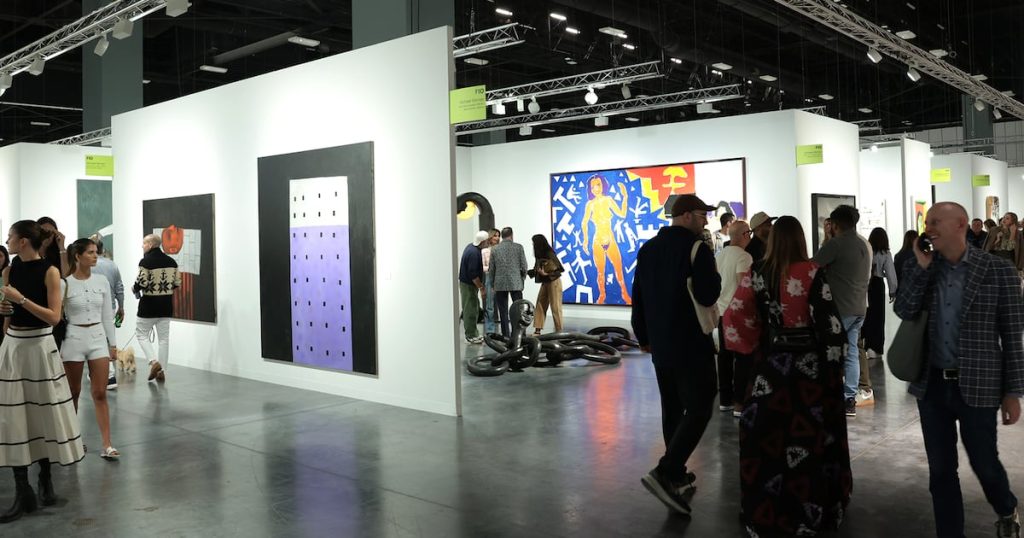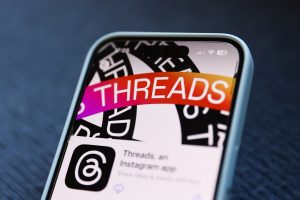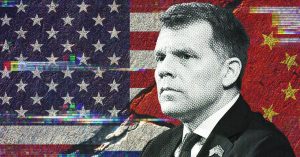The art market has seen better days. Galleries are closing in Manhattan, and according to The Art Newspaper, aggregate global auction sales at Christie’s, Sotheby’s, and Phillips fell 27 percent in the first half of 2024.
But one very important demographic is still banking on fine art: luxury fashion brands. Just this week, Louis Vuitton announced a re-edition of a popular aughts-era collaboration with the artist Takashi Murakami, and several labels, including Gucci, Hublot and Cartier, are currently putting on activations at Miami Art Week.
The luxury world’s lasting affinity for art will be readily apparent at Art Basel Miami Beach, which opens to the public on Friday. On Tuesday, Pucci hosted a private “fun fair” at the Miami Beach Botanical Garden next to the convention center itself with invite-only guests such as the rapper Gunna in attendance. On Wednesday, when VIP previews for Art Basel Miami Beach started, LVMH opened a five-day pop-up in Miami’s design district to host panels with artists, LVMH Maison executives, influencers, and more. Other high fashion brands are using Art Basel Miami Beach as an opportunity to energise new releases. Off-White will celebrate the release of its debut golf capsule with Paris Hilinski at its Miami design district flagship on Thursday, right after Maison Margiela unveiled an artist collaboration with the tattoo artist Kozo at its own Miami flagship on Wednesday.

The last major annual art fair of the year will draw in 286 galleries around the world, making its host city a magnet for traditional blue-chip collectors and new-money crypto entrepreneurs. Luxury brands are counting on both to help reverse a downturn that’s seen sales stagnate or decline at most major brands. Art Basel Miami Beach serves as ground zero for a new class of American luxury consumers who are feeling flush post-election: the US stock market has hit an all-time high, the Fed handed another interest rate cut in November and Bitcoin’s value surpassed $88,000 for the first time a few days later. Crypto wealth drove sales for luxury brands in the immediate aftermath of the pandemic, and while the market has cooled in recent years, it’s coming roaring back: Justin Sun, the Chinese crypto entrepreneur who made headlines in 2021 for spending over $100 million on blue-chip artwork by both the coveted 20th century sculpturist Alberto Giacometti and the graffiti-artist-turned-pop-art-phenomenon Kaws, also came back in the news last month for purchasing Italian artist Maurizio Cattelan’s “Comedian” (aka the viral duct-taped banana) at Sotheby’s for $6.2 million. The Crypto entrepreneur’s interest in contemporary art clearly has not waned.
Beyond the crypto millionaires, today, Art Basel Miami Beach — and fine art at large — is reaching a broader cross-section of consumers, which is why even non-luxury players such as the hybrid streetwear magazine and retailer Complex NTWRK and BDG-owned publication Nylon are activating on the event’s periphery. Complex NTWRK is partnering with the Japanese artist Verdy to debut two new sculptures and release collaborative merch; Nylon will host its annual party on Dec. 6.; Highsnobiety will host a series of events in the design district that are partnerships with brands ranging from the sportswear label Hoka to the Pharrell-owned auction platform Joopiter.
“Hundreds of thousands of people come into town to check out parties, fashion pop-ups, sneaker releases, and other non-endemic brand activations,” said Complex NTWRK CEO Aaron Levant. “All these people have a huge crossover into young pop culture, streetwear, hip-hop, all the way into the blue-chip art market. Things are democratising and there isn’t a wall up.” (Disclosure: The author previously worked at Complex.)
A Growing Crowd
That intersection could still be found in the enduring popularity of artists such as Kaws, best known for his skull characters and an approachable take on pop art that references his previous practice as a subversive graffiti artist. Nearly half a decade after shattering auction records at Sotheby’s in 2019, he continues to be embraced by not only luxury brands but mass-market fashion labels. In November, the American artist unveiled a new capsule collection with Dior and a watch made in collaboration with Audemars Piguet, while in August, Uniqlo also revisited a Kaws collaboration to promote an ongoing exhibition that juxtapositions Kaws’ artwork with pieces in the Andy Warhol Museum. The everlasting nature of these collaborations speaks towards the new American luxury customer and evolving art consumer that could be found in Miami this week.
So while luxury labels are targeting those likely shopping for blue-chip canvasses at Art Basel, Levant sees potential in a broader crowd in Miami that he likens to those who attend his brand’s own annual streetwear festival ComplexCon. He points out how the same brands that show up for his convention are also activating and sponsoring events in Miami’s design district alongside luxury players. For example, this weekend, Nike will activate at the Miami outpost for the heritage American streetwear boutique Concepts to promote a highly-anticipated reissue of a sneaker collaboration by the graffiti artist Stash. That’s what’s bringing Sky Gellatly, co-founder of the creative agency Icnclst, to Miami this year while also supporting his client Futura—who’s also set to release an exclusive collectable in what will be the third and largest iteration of the Art Basel Shop curated by Sarah Andelman of Colette.
“Art Basel Miami, compared to Art Basel Paris, there’s always far more presentations of artist fashion collaborations. As a function of that, the design district has this plethora of stores and brands that traditionally prioritise artist collaborations in general,” said Gellatly, whose agency forges art partnerships with brands such as Louis Vuitton and Comme des Garcons. “The Miami design district provides the best hotbed to launch experiences around artist collaborations in adjacency to the fair.”
Generally, commercial art collaborations are thriving culturally with the rising merch-ification of art that has led to a boom in everything from branded museum apparel to omniscient collaborations with fine artists such as Daniel Arsham — who was recently named the first global creative director of ComplexCon after releasing his own watch collaboration with Hublot this year. According to Licensing International, a trade organisation for the larger licensing industry, global sales revenue from licensed merchandise and services connected to art properties reached $3.68 billion in 2023, a 3.5 percent increase over 2022 and up from $2.71 billion in 2018. Andrea Fisher-Scherer, a managing director for merchandise licensing for the Artist Rights Society, which represents over 122,000 artists worldwide, added that 2024 was a more fruitful year for licensed art collaborations.
Gellatly believes that, aside from the commercial success of such collaborations and the shared creativity between fashion designers and artists, what has accelerated fashion-art collaborations is how art has become democratised within the past decade. People now have greater connectivity to artists via social media, leading art fairs such as Art Basel or Frieze to become larger cultural tentpole moments.
“There’s a level of virality around that type of [collaboration] work whereas in the nineties or eighties, it would appear just in a print magazine…” said Gellatly. “It could just be hidden in the annals of time almost, whereas now, everyone sees it in real time. The level of visibility and function is way higher for it.”
And perhaps why we won’t stop seeing art collaborations with the same big pop artists is also why we won’t see luxury brands decamping from Miami anytime soon.





